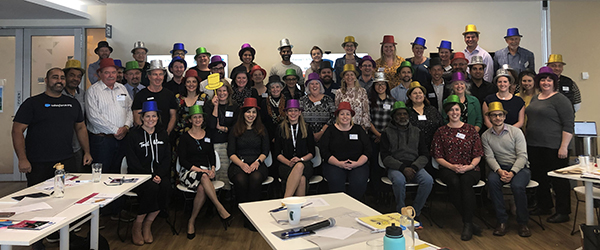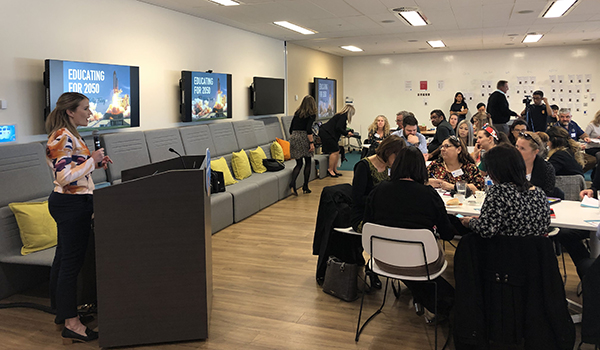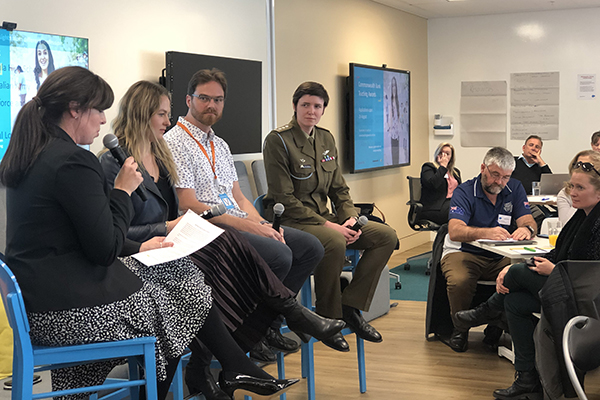Earlier this month, Australian Schools Plus and Salesforce held a fantastic Schools Plus Collaboration Forum in Sydney.
We caught up with Schools Plus Director of Donor Relations Sherrill Nixon and Salesforce.org’s APAC Director Davinder Mann to find out more, sat in on a couple of sessions at the event, and asked a few of the teachers about their schools and students.
Q: What was the Schools Plus Collaboration Forum all about?
Sherrill Nixon: There’s never a bad time to support disadvantaged schools in their quest to help students develop STEM skills (and we do it all day every day!). But in the same week as the ABC turned a MySchool dataset into an interactive tool showing that Australia’s four richest schools spent more on capital works than the poorest 1800 combined, it did seem particularly apt.
So, in partnership with Salesforce, we brought five Schools Plus coaches, inspiring speakers, and 43 teachers and principals from 41 disadvantaged primary and secondary schools all over the country to Sydney. For two days, the teachers could focus on building their ability to reach the kids and other teachers in their schools, to teach and promote the teaching of STEM skills and mindsets.

Every teacher who was there is running a STEM project in their school, funded by Salesforce, and we wanted them to be even more inspired about those projects. We wanted to give them the time (a day out of the classroom is hard-won!) and structure necessary to build practical knowledge, skills, tools and networks that would help them inspire and prepare the kids they’re teaching for careers in STEM.
Last year, our first Collaboration Forum had 28 teachers from 18 schools, so to see the event so much bigger this year was really rewarding and a great reinforcement of the value it brings.
Q: Why is Salesforce involved in the program?
Davinder Mann: A few reasons. Firstly, we desperately need to build STEM skills in our future workforce, and Salesforce is really well positioned to help on that front.
But we also firmly believe in equality in access to education. Globally, our Circle the Schools program sees us support underfunded schools with training, time, money and more, and locally we partner with Schools Plus to ‘circle’ Australian schools. We consider the school sitting at the centre, with any resources we can provide looped around – our teams’ knowledge, our offices, our volunteer time, our funding.
So far we’ve contributed more than $1.7 million to the program, as well as our time and other resources, because what Schools Plus does in enabling schools to improve the educational outcomes of students is essential and built around moral purpose, and because no one else is doing it.
I heard one teacher say “We’re the champions of the students, and Schools Plus is the champion of us”. What better reason to support their work?
Q: What was your highlight of the event?
SN: For me it was the level of passion and expertise in the room. We heard from a pilot, entrepreneurs and engineers, each with a story to tell about the empowering nature of education. But the passion of the teachers, and their excitement to share expertise and encouragement, big challenges and even bigger wins, was awe-inspiring.
And given the difficulties faced by some of the schools we partner with, their continued dedication to helping their students become life-long learners and build better futures is something to behold.
I also loved the design thinking workshop to see which team of teachers could make a marble roll for the longest time using just cardboard and tape. Sounds simple, unless you want to win! It was not only a chance to see the power of a design thinking approach to problem-solving, but a practical activity to take back to the classroom.
DM: My highlight – apart from seeing the real impact of our support – was hearing the speakers who’d built careers as rockstar engineers saying that they’d been ‘ordinary’ students, not the ‘star’ pupil at school.
Felicity Furey was one of those speakers who didn’t make her success look easy. She was encouraged by her high school physics teacher to apply for engineering at university, but she had doubts at the time about whether she was cut out for it.
She’s now changing engineering education every day.
Felicity co-founded not-for-profit Power of Engineering, which has reached more than 9000 school students across Australia, changing the minds of 75% of students who had said a hard no to engineering.
She’s also co-founded Machinam to help motivate high school maths students by showing them how maths plays out in the world outside of the classroom.
Felicity Furey: from failing maths to STEM superstar
We sat in on Felicity Furey’s session, and couldn’t agree more that it was a highlight!
“I thought engineering was all about maths, and I hated maths,” she said. But her teacher had recommended engineering, so she listed it in her preferences for uni – as her fifth choice.
“Guess what?” she asked wryly. “I got in.”

Felicity walked into her first lecture and realised she was one of a handful of women – just 12 in a cohort of 300 students, it would turn out. And she didn’t love engineering; she struggled to see how what she was learning was relevant, and failed first-year maths.
In a second year project, though, she had to design a housing estate.
“Did you know that you can’t just design straight roads?” she asked the crowd. “People will treat them as racing tracks!”
Suddenly, she’d seen that the decisions she would make as an engineer were relevant to real lives, and creativity and empathy were in play. ‘Hard’ STEM skills like maths needed to be balanced with empathy and complex problem solving.
Felicity passed maths. She graduated, started working with Brisbane City Council, took on a $45m capital works portfolio and has been a passionate advocate of getting women into engineering ever since.
She brings her path to that effort – believing that real-life relevance is key to making engineering appealing to women. What does this look like in practice? Like sharing stories about how little Emma was able to play with toys, feed herself and hug her mum.
Or through activities that challenge kids to work out what songs a band should play on a world tour – developing insights from data to solve a real-world challenge that aligns with a teenage career dream. Or to work out how long until a city runs out of water – using data and maths to solve a clearly important and very real problem.
Based on her experience learning, practicing and developing STEM education, Felicity identifies a ‘STEM mindset’ that she says is more important than STEM skills:
- Resourceful
- Data-driven
- Creative
- Logical
- Human-centred
Panel: ‘Thinking like a … ’
We also joined the teachers to watch a panel of professionals who’ve built STEM careers: Salesforce’s Tamara Klink; Erin Pederick, a helicopter pilot in the Australian Army; and Aloys Baillet, R&D Senior Technical Lead, Performance at Animal Logic.

Their advice for students? Tamara urged young girls not to be scared of working in tech, to see it as an opportunity to be creative.
“Be passionate initially, she said. “Be adaptable and patient, work with diverse teams, build communication skills, and develop problem-solving and critical thinking skills.”
Erin, who’d talked attendees through her average day – including briefings, safety checks, flights and debriefs – included:
- Don’t be afraid of a challenge.
- Don’t be afraid of making mistakes – “every time you stumble or run into a roadblock it’s a learning opportunity”.
- Don’t just look straight ahead – “the path you were thinking you wanted to take, that’s just the one you knew about – so look around as well”.
Aloys and his team of five engineers develop tools used by Animal Logic’s animation and VFX teams on films including Happy Feet, Peter Rabbit, The Lego Movie franchise and more. He advises that students should:
- Keep an open mind even while their dreams might be narrow – “Have something to aspire to, but it doesn’t have to be the one thing you do all your life”.
- Be realistic – “Have the dream, but keep the realistic part of your brain in check as well”.
See how Animal Logic makes magic happen with engineering:



